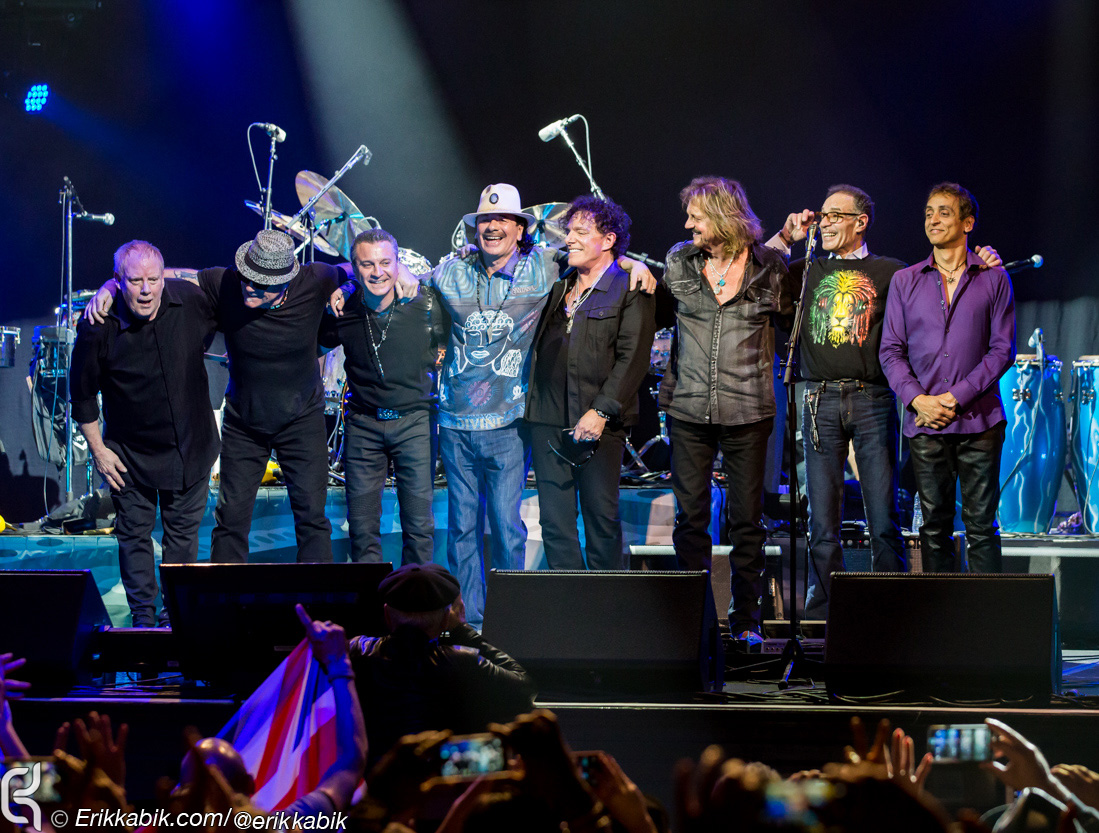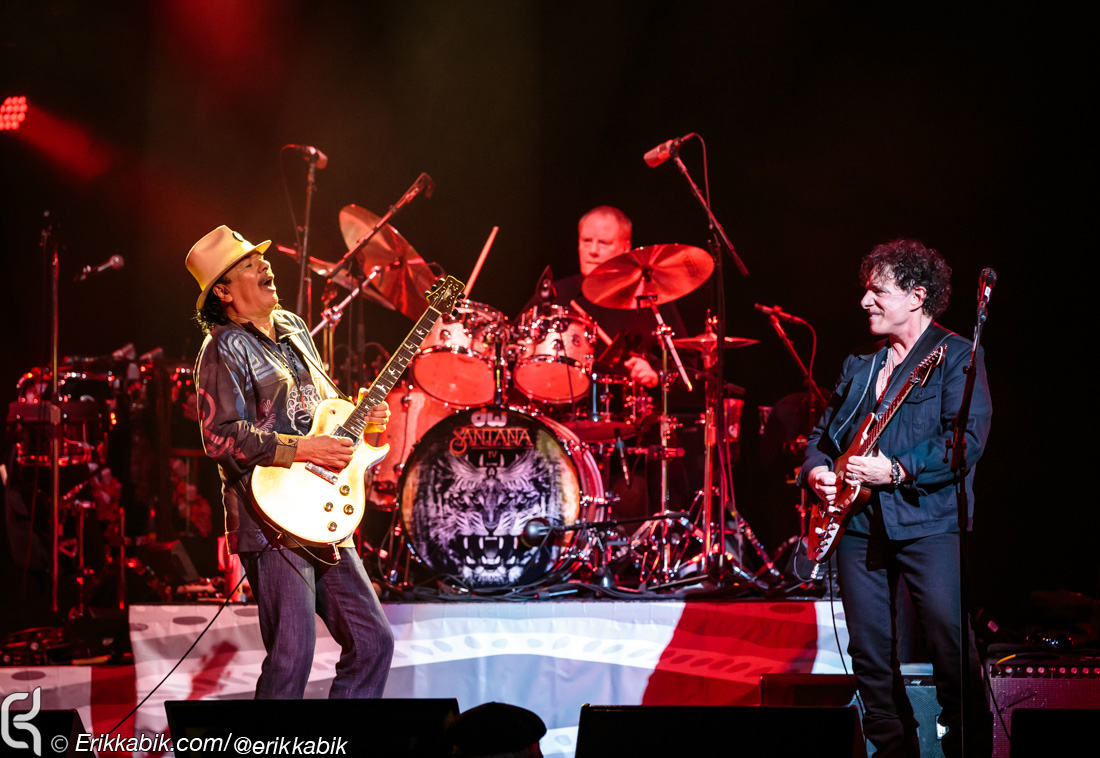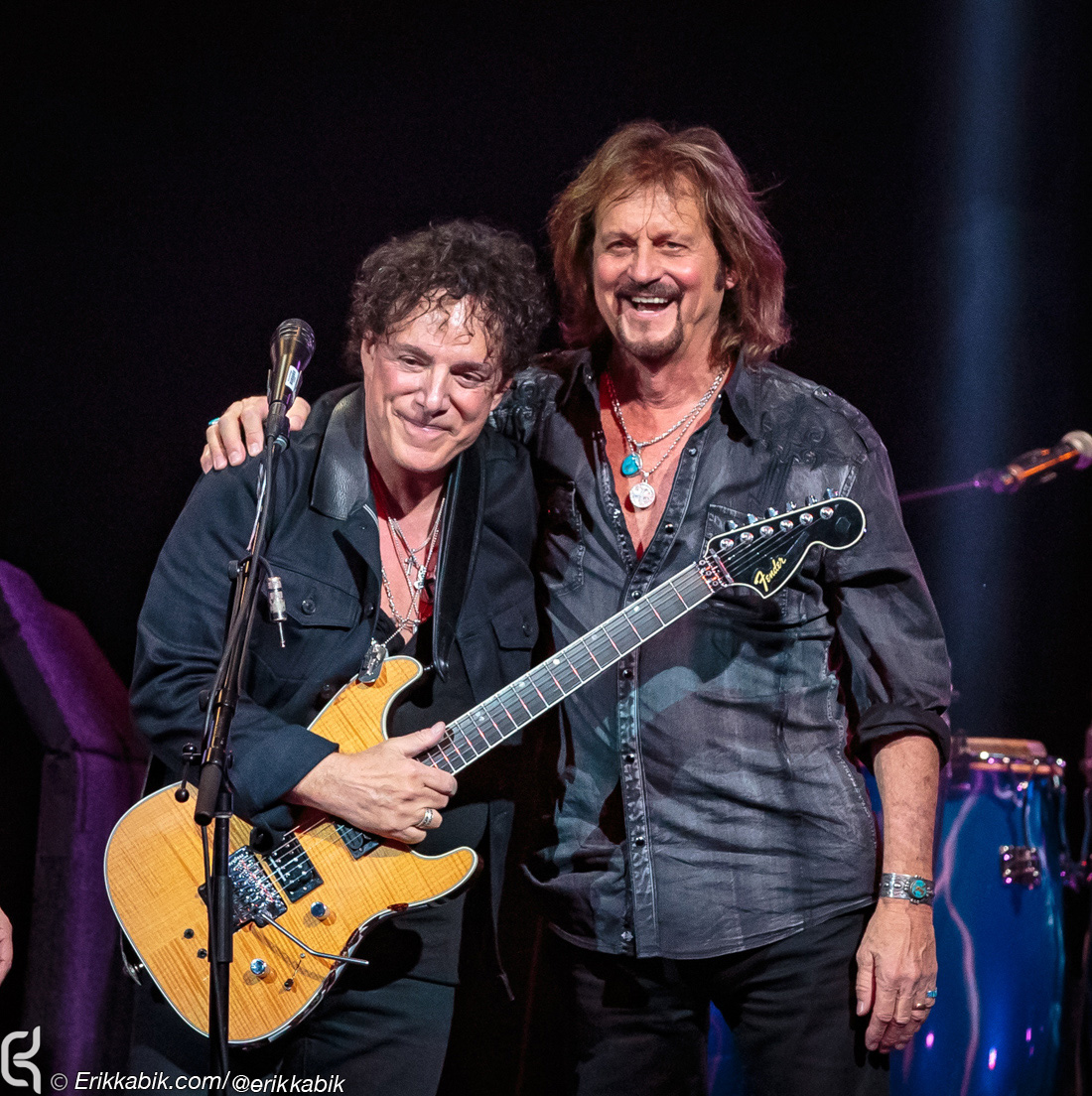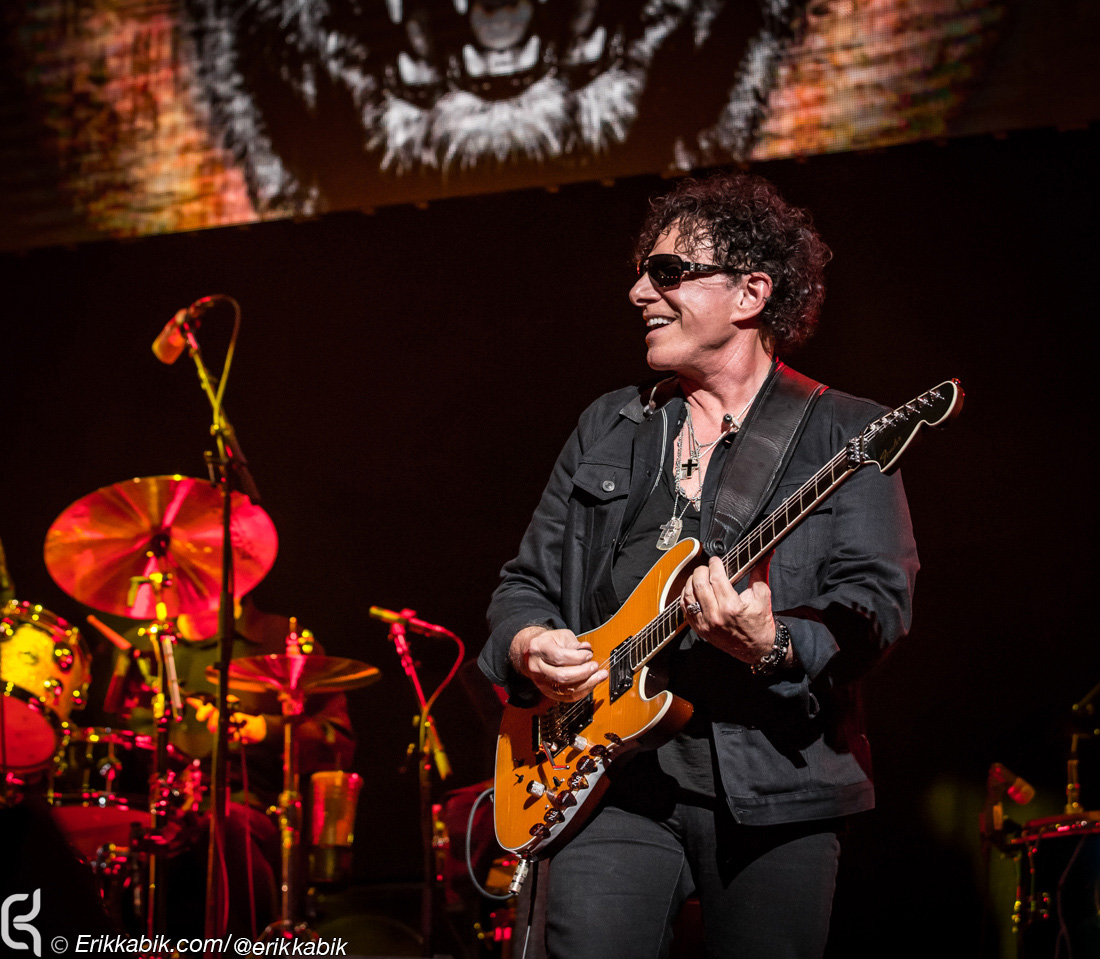Fillmore Fellow Travelers: Santana Reunites Classic ‘Santana III’ Band for New Album

To read more from this story as well as features from Band of Horses, Mudcrutch, The Claypool Lennon Delirium, Kamasi Washington and many others, purchase the June issue or subscribe here.
It took quite some time for the years to melt away.
The alchemy itself was nearly instantaneous, as decades dissolved within moments, expunged by a few musical notes. The moment of inception, however, required countless months of preparation.
“I’m so glad I chased this with Carlos,” explains time-travel catalyst Neal Schon. “I was on a mission, and I just thought how great it would be to go full-circle. I was met with a lot of resistance, but I kept running into him. It felt like an omen. If I was down at the mall in Corte Madera, [Calif.,] then he was there. If I went to a restaurant, then Carlos was there. He probably thought I was following him… and I was.”
Schon, who was still a teenage Bay Area guitar prodigy when he spurned an offer from Eric Clapton and joined the Santana band in late 1970— only to depart a couple years later to form Journey—laughs at his joke.
“Seriously, though, at some point, it felt like a sign from above that I should pursue this. Carlos finally said OK because I was driving him nuts. So we sat down and talked about what we could do together, and putting the original band together was part of that discussion. I knew there was going to be healing involved, but I really thought this would turn people’s heads around.”
Carlos Santana acknowledges that Schon’s pure intention and raw indefatigability finally held sway. “My heart surrendered to Neal because he was so gracious and vulnerable in the way he was approaching me. It’s a supreme compliment that Neal’s heart and his graciousness were so diligent. He was looking at me the same way I look at John McLaughlin, Wayne Shorter and Herbie Hancock. I needed to sit down with Neal and say, ‘That’s so complimentary’ because usually guitar players are like dueling banjos, and I never wanted to do that with him or Jerry Garcia or Eric Clapton or anybody.
“Some people want to compare or compete; I just want to complement and compliment. If Jerry Garcia goes up and down, then I’m going to go left and right. If Jerry Garcia goes left and right, then I’m going to go up and down. And Neal constantly put his ego aside in reaching out to me and saying, ‘I really want to play with you; I think we need to do something together.’”
While the impetus came from Schon, the musical direction flowed from Santana, who reflects, “When we finally decided, with clarity and integrity, to do a new album, I said, ‘Why don’t we call it Santana IV?’ Because I think, after the third album, it wasn’t Santana anymore. Caravanserai [the fourth Santana record] was an experiment. I think Santana III was the last collective, in unison—not looking over our shoulders at what Weather Report was doing or what Miles was doing. I thought, ‘Why don’t we accept that this is Santana IV, which is a continuation of Santana III.’”
Gregg Rolie, the group’s original keyboard player and vocalist, was touring with Ringo Starr in the Pacific Rim in early 2013 (at the same time Journey and Santana were making the rounds), when he received a few enthusiastic texts from Schon about the possibility of a reunion. “I called Carlos when I got home,” Rolie remembers, “and what he said was: ‘I want to get the guys together and call it Santana IV because the band stopped with Santana III.’ I thought that was brilliant because it should be Santana 40— he’s done so many recordings. But it expressed everything in those two words: Santana IV.”
Originally dubbed the Santana Blues Band, Carlos’ group was a true product of the collegial Bay Area music scene of the late 1960s. “I take it as a badge of honor,” the guitarist says, “when I tell people, ‘One minute I’m in Mission High School, and then, the next second, I’m playing on a truck at the Panhandle, and I just smoked a joint, and I’m playing ‘Jingo’ and ‘Chim Chim Cher-ee’ from Mary Poppins, and I open my eyes, and I’m sweating, and there’s Jerry Garcia and Michael Bloomfield, looking at me and laughing.’ Not laughing at me, laughing with approval.”
 The classic Santana lineup that would regroup over 40 years later originally came together piecemeal. In 1965, percussionist Michael Carabello was a high school student at San Francisco Polytechnic. Mutual friends introduced him and Carlos, who was then attending the nearby Mission High. The two shared a similar sensibility, and Carabello joined the guitarist’s nascent group, which was just starting to emerge from a blues-based aesthetic through exposure to artists like Gábor Szabó, Chico Hamilton and Willie Bobo.
The classic Santana lineup that would regroup over 40 years later originally came together piecemeal. In 1965, percussionist Michael Carabello was a high school student at San Francisco Polytechnic. Mutual friends introduced him and Carlos, who was then attending the nearby Mission High. The two shared a similar sensibility, and Carabello joined the guitarist’s nascent group, which was just starting to emerge from a blues-based aesthetic through exposure to artists like Gábor Szabó, Chico Hamilton and Willie Bobo.
Similar to many like-minded area musicians, Carlos was a steady presence at the Fillmore Auditorium, taking in all that promoter Bill Graham had to offer. One night, in October of 1966, during a chaotic set by the Butterfield Blues Band in which Paul Butterfield sat out due to an intense acid trip and Michael Bloomfield moved to organ— subbing for an absent keyboard player—one of Carlos’ friends secured an invitation for him to sit in for “Good Morning, Little School Girl.” He soloed alongside Jerry Garcia, who had showed up to lend a hand.
Santana’s efforts earned him a return invitation from Bill Graham, which soon yielded a new bandmate. A week later, Carlos was washing dishes at the Tic Tock hamburger stand when Tom Fraser, a singer and rhythm guitarist from Palo Alto, who had seen him at the Fillmore, tracked him down and invited him to a jam session. Carlos hopped into Fraser’s car for a ride out to a Mountain View, Calif., farmhouse, where he plugged in opposite keyboard player Gregg Rolie. 
Rolie, who was also a teenager at the time, was playing in a Paul Revere & The Raiders knockoff band called William Penn & His Pals. Rolie’s group, which donned tricorn hats and uniforms, had gained a local following by performing the music of The Animals, The Yardbirds and The Rolling Stones.
Rolie recalls, “When I met up with Carlos, I realized he was doing exactly what I wanted to do, which was make my own music. We played in this farmhouse. It was all open field at the time, but it’s right where Shoreline [Amphitheatre] is now. We were playing real loud and the police showed up, and Carlos was 20 yards in front of me headed for this tomato patch. I thought it was a great idea and I joined him in the tomato patch.
“From then on, I was driving or hitchhiking from Palo Alto to San Francisco and working on Santana while I was going to college. I was going to be an architect, or try to be one, and the turning point was when I had a little meeting with my dad, who said, ‘You can’t do both. Give it five years and, if anything happens, great, and if not, you can always go back to school.’ That was his advice and I took it. I didn’t become an architect.”
Drummer Michael Shrieve’s indoctrination into Santana has a similar ring. He explains, “Michael Bloomfield and Al Kooper were playing [at the Fillmore], and I called all of my friends and said, ‘Let’s see if we can sit in.’ Everybody thought I was crazy, but I wanted to say I’d tried because Bloomfield was the Eric Clapton of America. I went up to him and asked if I could sit in, and he said, ‘Let me ask the drummer. He’s a really nice guy.’ So it happened and that was a big deal for me. Santana’s bass player, David Brown [who passed away in 2000], was there, along with their manager, who said, ‘We’re thinking of getting another drummer, and you sounded good. Can I get your number?’ I gave it to them and I never heard from them.
“Then, one day, as I was walking into this studio in San Mateo where I was hustling time, their drummer was literally walking out the door— they just had a falling out. A couple of the guys remembered me from that night, asked me to jam and then they asked me to be in the band right then and there. They followed me home to my parents’ house, where I woke up my folks and said, ‘See you later.’”
As Rolie describes it, although they were all still in their teens and early twenties, “The seriousness we had toward the music was everything. Carlos played with his back to the crowd. We played to each other, like jazz guys. It wasn’t some act going to the tip of the stage—it was all about the music itself. The most important thing was: How did it sound and where are we going with it?”
They developed that sound at Bill Graham’s Fillmore Auditorium (and later the Fillmore West) not only through their own performances, but also by soaking in the eclectic music bills at those venues. The diverse lineups served as a template for the music that the group would come to perform. Santana acknowledges, “You become what you love, you become what you adore—Miles opening up for the Grateful Dead or the Grateful Dead and Sun Ra or the Grateful Dead and Babatunde Olatunji. Then, it was Jeff Beck with Rod Stewart, headlining over Sly Stone, when Sly Stone was dangerous—this was before Woodstock. The Doors opening for The Young Rascals. Jimi Hendrix opening for Gábor Szabó and Jefferson Airplane. It was incredible and I was at the ground zero for adventure. Bill Graham was like Barnum & Bailey, Ringling Brothers—he was the ringmaster.”
During the summer of 1969, that ringmaster traveled to Bethel, N.Y., lending his assistance to the foundering Woodstock Music & Art Fair, on the condition that Santana, whose first album still had not been released, could join the lineup. Under Graham’s aegis, the group was in the Catskills a few days before the event took place and their very presence—at a time when traffic choked to a halt—thrust them into the spotlight through a spontaneous Saturday afternoon set. Originally, they were told they would appear three slots after the Grateful Dead, but when Jerry Garcia explained to Carlos that the Dead’s set would extend past midnight, Garcia offered some mescaline to help bide the time—so that when Santana performed more than 12 hours earlier than expected, Carlos discovered that his guitar had transformed into an electric snake, which accounts in part for the animated facial expressions that brighten the Woodstock documentary. The group’s career-making performance was amplified by the imminent release of their debut record, followed by the Woodstock film six months later.
By the time Santana started recording their second studio album, which would be called Abraxas, they had become international superstars. Yet despite the trappings and potential distractions that come with fame, they remained musical free spirits, still eager to pursue new collaborative opportunities that promised creative exhilaration. Such a prospect led Rolie to invite local guitar prodigy Neal Schon into the studio during the Abraxas sessions. Just 15 years old, Schon was the son of a jazz musician who moved his family to the Bay Area from New Jersey when Neal was 6 years old. Schon studied woodwind instruments under his father’s tutelage but, eventually, migrated to the guitar. “I got frustrated because he didn’t have much patience to teach me, so I decided to play something that he didn’t play,” he explains. 
Schon devoted himself to the instrument from the age of 9 and, as a young teenager, turned heads. He became friendly with brothers John and Jack Villanueva, Santana crew members who took an interest in him. “Jack picked me up every week, took me into the city and introduced me to all of the club owners. He brought me to the Keystone Korner, where Elvin Bishop had this thing every week, where guitarists of all ages would have a shootout onstage for the title. I ended up keeping the title, so Elvin was kind to me. One night, he said, ‘We’re going to go down to the Fillmore. B.B. King is playing there, and I’m going to introduce you to him, and we’re probably going to be able to go onstage and jam with him.’ That was the first big show I ever played. I had studied all B.B.’s music, and we had a cool exchange onstage. I knew his picking style, vibrato technique and choice of notes, so he’d hit a note, and I’d look over and answer him. I had a lot of chops—I could be fast—but I decided to slow down, be tasty and show him respect. He loved that and we became friends. I played with him many times after that. The same thing happened with Albert King.”
Gregg Rolie became a booster and advocate. “He was brilliant at 15. It was amazing. He could play more of that Clapton stuff than anybody I’d seen, and he had that air about him. So I brought him around during Abraxas, thinking I would love to have his guy in the band, but it wasn’t my place to go, ‘We should have another guitar player.’ Although I thought it would be a great idea because they played differently. It could open up yet another color in this electric music we call Santana.”
A moment of truth arrived when Eric Clapton came to town with Derek & the Dominos. Bill Graham facilitated an informal gathering at Wally Heider Studios that swiftly evolved into a jam session. Carlos sat out after ingesting some psychedelics, but Schon dazzled Clapton, earning him an invitation to make a guest appearance the next night at the Berkeley Community Theatre. It went so well that Clapton asked Schon to join the Dominos, which, in turn, prompted a similar offer from Santana.
Shrieve laughs. “So here was Neal in the schoolyard the next day asking himself, ‘Hmmmm, should I go with Eric Clapton or should I go with Santana?’”
While flattered, Schon opted to play for the home team, which he held in the highest regard. Schon also had an inkling that drugs were taking their toll on Clapton and his group. He had arrived at the Berkeley Community Theatre to find everyone asleep. “I thought, ‘What’s going on, man?’ Even being that young, I sensed that there were some issues.”
Although his bandmates were somewhat surprised at Carlos’ willingness to welcome Schon into the fold, the band’s namesake explains, “Everywhere I looked, people were having two guitar players: Jerry Garcia and Bob Weir, Duane Allman and Eric Clapton, even Peter Green went out and got another guitar player. So I was like, ‘OK, there’s something about two voices creating one symmetry.’ I remember Miles Davis asked me, ‘Why did do you do that?’ I told him, ‘Because that’s what my heart told me to do.’ He said, ‘I think it’s a big mistake.’ Consequently, he had two guitar players: Pete Cosey and Reggie Lucas. At one point, he’d also had Sonny Sharrock and John McLaughlin.”
With Schon in place, the band started working on their third record, which would become the group’s second consecutive No. 1 album (and the group’s final chart-topper until Supernatural, 18 years later). Opening with the vibrant instrumental “Batuka,” featuring the guitarists’ twin leads, the record also includes the ebullient “Everybody’s Everything,” which became a pop hit, and the burning, FM-radio favorite “No One to Depend On,” both of which emphasized Schon’s new role with the group. Other tracks, including “Toussaint L’Ouverture” and “Guajira,” remain Santana setlist staples to this day. The band traveled back and forth across North America and touched down on five continents, earning lavish accolades for their dynamic live shows.
However, the road lifestyle began to take a toll on the group and, during the fall of 1971, Carlos said goodbye to his longest tenured bandmate, Michael Carabello. The guitarist had grown frustrated with an increased cocaine presence and staged a sit-down strike, leading the group to begin a tour without him. Schon helped persuade Carlos to return, but this also necessitated a personnel purge, which included Carabello.
By the time that Santana entered the studio for their next record, in the spring of 1972, a deeper schism had developed. Carlos writes in his memoir, The Universal Tone: “We had gone from rooting for each other to tolerating each other to being two bands in one, in conflict musically and philosophically.”
Carlos’ vision aligned with Michael Shrieve’s, who explains, “Bitches Brew was happening with Miles, and Return to Forever with Chick Corea, Lenny White and Stanley Clarke, and also Weather Report. It seemed like that was where the shit was happening, rather than just more rock-and-roll music. He and I were moving in a different direction, spiritually, from the rest of the band, and we went guru shopping as well.”
Rolie attests, “I didn’t want to play all ethereal. I thought the exploration became more than the music we were doing. I thought it was great to educate our audience, but I didn’t want to lose them.”
As it turned out, the Santana audience would lose both Rolie and Schon by the time of October’s Caravanserai release and tour.
After breaking from Santana, Rolie initially put the music world behind him, opening a restaurant with his father in Seattle. While he entered this partnership with great optimism, the venture began to take a toll on him. (“It’s like going from the pan to the fire. You think the music business is tough, try restaurants—you need 4,000% capacity to make it happen because no one’s going to eat in the same place every day.”) So, when he received a call from Neal Schon about the possibility of joining a new project to be managed by former Santana roadie Herbie Herbert, Rolie decided he was ready to reenter the music world.
“Originally, it was going to be called the Golden Gate Rhythm Section,” Rolie says, “and we were going to be a backing band for solo acts that came into town, like the Eagles did a few years later with Linda Ronstadt. But, that idea didn’t last long. Within two weeks, we started writing and everything came together. We needed a new name and that’s how we became Journey.”
For more from this story as well as other content, purchase the June issue of Relix. To subscribe, click here.



















